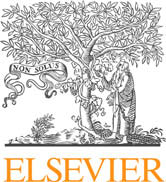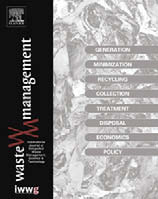2. Materials and methods
2.1. Feedstock selection
Biomass feedstocks were collected within and around the IISc
Campus in Bangalore, India. Previously recorded zone-wise
OFMSW collection data suggested a predominance of fruit and
vegetable wastes (FVW), leaf litter, and paper fractions (Sateesh
Kumar et al., 2001). Cabbage waste, banana peels, and orange peels
have been found to be the most predominant components of FVW
in a few zones (Chanakya et al., 2007b). Citrus peels have been reported
to cause some form of inhibition of gas production and
therefore are required to be fermented separately from other feedstocks
(Mandal and Mandal, 1997). Leaf litter constitutes about
35% of the overall waste collected and varies with the season (Sateesh
Kumar et al., 2001; Chanakya et al., 2007b). The decomposition
of a few leaf biomass feedstocks has been reported earlier
(Chanakya et al., 1999). For this study, we chose bamboo and teak
leaves, for which there were no fermentability data. Newsprint
fermenting in the presence of another biomass was also studied.
Thus, a total of six individual feedstocks were studied, as shown
in Table 1.
Table 1: Weights of samples used to determine the decomposition rates in a PFR
Substrate |
Fresh weight, g |
Cabbage |
200 |
Banana |
200 |
Orange |
120 |
Teak leaves |
50 |
Bamboo leaves |
30 |
Paper |
40 |
2.2. Fermentation pattern
Freshly collected feedstocks, cut to 10–25 mm pieces, were weighed and placed in nylon mesh bags of size 20 x 15 cm (Table 1). Between 50 and 200 g fresh weight of the substrate was used in each of the bags, so that at the end of the 10–30 d decomposition period, at least 4–5 g of undigested feedstock would remain in the bag for analysis of composition and to determine what fractions were lost. To facilitate easy sampling, the five different feedstocks (other than orange peel) in duplicate were bundled together such that they could all be removed at a time. The nylon mesh bags containing orange peels were subject to fermentation separately (on the other side of the inlet of the same PFBR), in order to avoid possible toxic compounds leached from digesting citrus fruit peels affecting the digestion of other feedstocks. They were kept separately in the digester at a distance of approximately 1 m away from the rest of the feedstocks but still within the PFBR inlet zone where conditions did not significantly vary from the location used for the other samples. This precaution was taken because previous studies suggest that there could potentially be toxic or inhibitory substances produced during the decomposition of citrus peels (Mandal and Mandal, 1997). Eight bunches of the feedstock bags, with each bunch having ten individual bags (five feedstocks in two replicates), were placed in the inlet region and weighted down with granite blocks. After the first day, the PFBR was operated normally with daily feeding composed mainly of garden wastes or tree leaf biomass at about 1 kg TS/m3/d. The choice of leaf biomass feedstocks and feed rate ensured that, during daily operation, these feedstocks did not, by themselves, produce inhibitory concentration of VFAs within the inlet zone of the digester. Care was taken to ensure that these samples were not physically damaged during the daily feeding operation. The contents of these bags were allowed to digest within the inlet region for various time intervals, based on previous information regarding the time intervals necessary to record sufficient levels of change (0, 2, 4, 7, 10, 15, 22, and 30 d) (Chanakya et al., 2007a). By using this method, we envisaged that the pattern of decomposition recorded would emulate the rate and pattern of decomposition of individual feedstocks (in the inlet zone) undergoing decomposition in a typical multi-feed operated PFBR that is predominantly fed OFMSW.
The estimation of the level of degradation of subcomponents of each feedstock was carried out by Chesson’s (1978) method, for SRT values of 0, 2, 4, 7, 10, 15, 22, and 30 d. Residual feedstock samples removed from the nylon mesh bags at these time intervals were oven dried at 90° C to prevent breakdown of carbohydrates. The dried samples were powdered in a laboratory grinder, and any fiber remaining was cut and reground to obtain a fine particle size. Two 1 g samples were used in this analysis, involving sequential extraction for various sub-components for each of the decomposition periods studied. During sequential extraction in various extractants (Chesson, 1978), the leachate samples collected were tested for their total carbohydrate (phenol sulphuric acid method) content and for protein (Lowry’s method, data not shown) content. In this study, residual biomass was fractionated into six fractions representing increasing difficulty for anaerobic decomposition, namely : hot water extractable pectin and related substances; ammonium oxalate soluble pectin; dilute acid (0.5 M H2SO4) extracted hemi-cellulose; 72% acid extracted cellulose; residual lignin; and ash remaining after combustion in the lignin fraction. The procedure used (Chesson, 1978) involved only one modification. The material remaining after extraction with 72% sulphuric acid was extracted from the sintered glass crucible after weighing. The extracted mass was weighed once again and was placed in a muffle furnace at 600° C for 1 h to determine the presence of salts and minerals.
The loss of TS and VS was also determined for the above time intervals using standard methods.
2.3. Biological methane potential (BMP) assay
BMP has been used as a quick and inexpensive method to determine the gas potential as well as the rate of conversion of feedstocks to methane during digestion, and it is reported in various ways (anaerobic biogasification potential assay (Chynoweth et al., 1982; Gunaseelan 1997)). Methane content of the gas is also a good indicator of process stability. Under normal circumstances, this value is a function of the H/C ratio of the biodegradable fraction, and it is normally in the range of 50–60% for MSW fractions (Owens and Chynoweth, 1993). Since methanogenic activity is the key factor leading to imbalance, a reduction of methane gas content is a key performance parameter and has been employed as an on-line control parameter. The biochemical methane potential assay (Owens and Chynoweth, 1993; Owen et al., 1979; Chynoweth et al., 1991, 1992, 1993) is normally useful for estimating the ultimate methane yield and relative conversion rates of feed samples. This assay may also be used to determine the toxicity of feed components. In this study, the BMP assay provided data on potential inadequacies, imbalances, or toxicities within feedstocks. This test was carried out in 135 mL serum vials with 1.0% (0.5 g/vial) of dried and powdered feedstock to which 49.5 mL of inoculum was added. To protect the inoculum from air, the headspace was first purged very rapidly with biogas to remove traces of air. These vials were crimped tight with aluminum seals. Subsequently, these vials were purged with oxygen-free nitrogen to remove traces of methane and oxygen, if any. Purging with biogas provided the necessary protection for about 1 h – the time required for the last vial to be purged with N2 from a cylinder. These vials were then labeled and incubated upside down (to identify leaks, if any) in an incubator at 30° C. At frequent intervals, the biogas quantity produced was determined by downward displacement of water (acidified dichromate) into an inverted burette, and the gas produced was measured off the burette.
A methanogen-enriched inoculum was prepared and used in the following manner. Digested wet biomass removed from a PFBR (3 kg) was shaken well in 10 L of digester liquid collected at the outlet of the PFBR. Digested biomass was allowed to disintegrate into this digester liquid by manual shaking, and allowed to settle down for 1 h. All floating and settled mass was skimmed or decanted. The remaining mass was filtered through cloth, leaving only fine particles in suspension. This was stored in an air-tight polythene can. For the first 7 d, 1 g of sodium acetate was added on a daily basis. The pH was monitored daily. After 7 d, the liquid was fed 1 mL of acetic acid on alternate days until 20 d. The gas production from this liquid was monitored frequently at 3 d intervals in 135 mL vials. Acetic acid feeding was stopped on the 20th day. On the 24th day, after gas production came down to low background levels (<1 mL/50 mL in 3 d), the material was used as inoculum to overcome the low aceticlastic methanogenic activity.
After each estimation of gas production in the inverted burettes, the gas in the headspace of these vials was tested for its CH4 and CO2 composition using a gas chromatograph with a Porapak-Q column and a thermal conductivity detector (150 ll sample) with H2 as a carrier gas. Using the initial and final composition of head space gas and the total volume of gas, the CH4 and CO2 produced were calculated for each time interval as shown below. During this assay, the occurrence of low levels of CH4 in relation to CO2 in the BMP assay has been considered a diagnostic tool for a stalled methanogenesis process.
[( Vgas + 84) x Mcurrent ] - [84 x Mprevious ] = methane produced in mL during the specified time interval whereMis methane fraction measured by the GC minus the current
and immediately previous reading, and 84 is the headspace volume.
The same method was used for estimating the quantity of CO2
produced during each time interval.
| E-mail | Sahyadri | ENVIS | Energy | GRASS | CES | IISc | E-mail |



